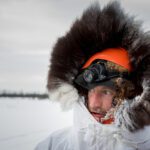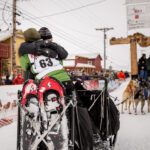The Iditarod Trail Sled Dog Race is an icon of Alaska.
The 1,000-mile competition from urban Anchorage to rural Nome traverses a wide diversity of Alaskan wilderness (and, ultimately, ends just a few blocks from KNOM studios). By showcasing dog mushing – and by passing through many of Alaska’s most storied, small communities – the race not only inspires and captivates many of our listeners but also celebrates the culture fundamental to our region. It’s for this reason that KNOM has covered the “Last Great Race” since its inception in 1973.
In 2014, thanks to you, KNOM again rallied to cover the Iditarod – in what turned out to be a red-letter year both for KNOM and for the race itself.
In part because of persistently warm temperatures earlier in the winter and a consistent lack of snowfall across the state of Alaska, this year’s Iditarod trail was “hard and fast.” Icy and bare, it made for exceptionally fast racing for the sled dogs but rough riding for their human mushers. Eight and a half days after the race began, the 2014 Iditarod champion, Dallas Seavey, had shattered the finish-line speed record. Largely because of the challenges of the trail, however, many of Seavey’s competitors were forced to withdraw (or “scratch”); among them was four-time Iditarod champion Jeff King, who, for a time, seemed almost inevitably poised to win the 2014 race.
It was an incredible, captivating race to follow, and this year, for the first time, KNOM sent two correspondents along the Iditarod trail, all the way from Anchorage back to Nome. Laureli Kinneen reprised her role as a trail reporter, sending back audio interviews for our airwaves, while David Dodman worked as a blogger and photographer, making posts to this website. The pair’s reporting and travel expenses were made possible through special underwriting and sponsorship from local and regional organizations.
In the photos above, you’ll find a small sampling of moments from this year’s Iditarod. For much, much more, explore all of our posts from Iditarod 2014.








